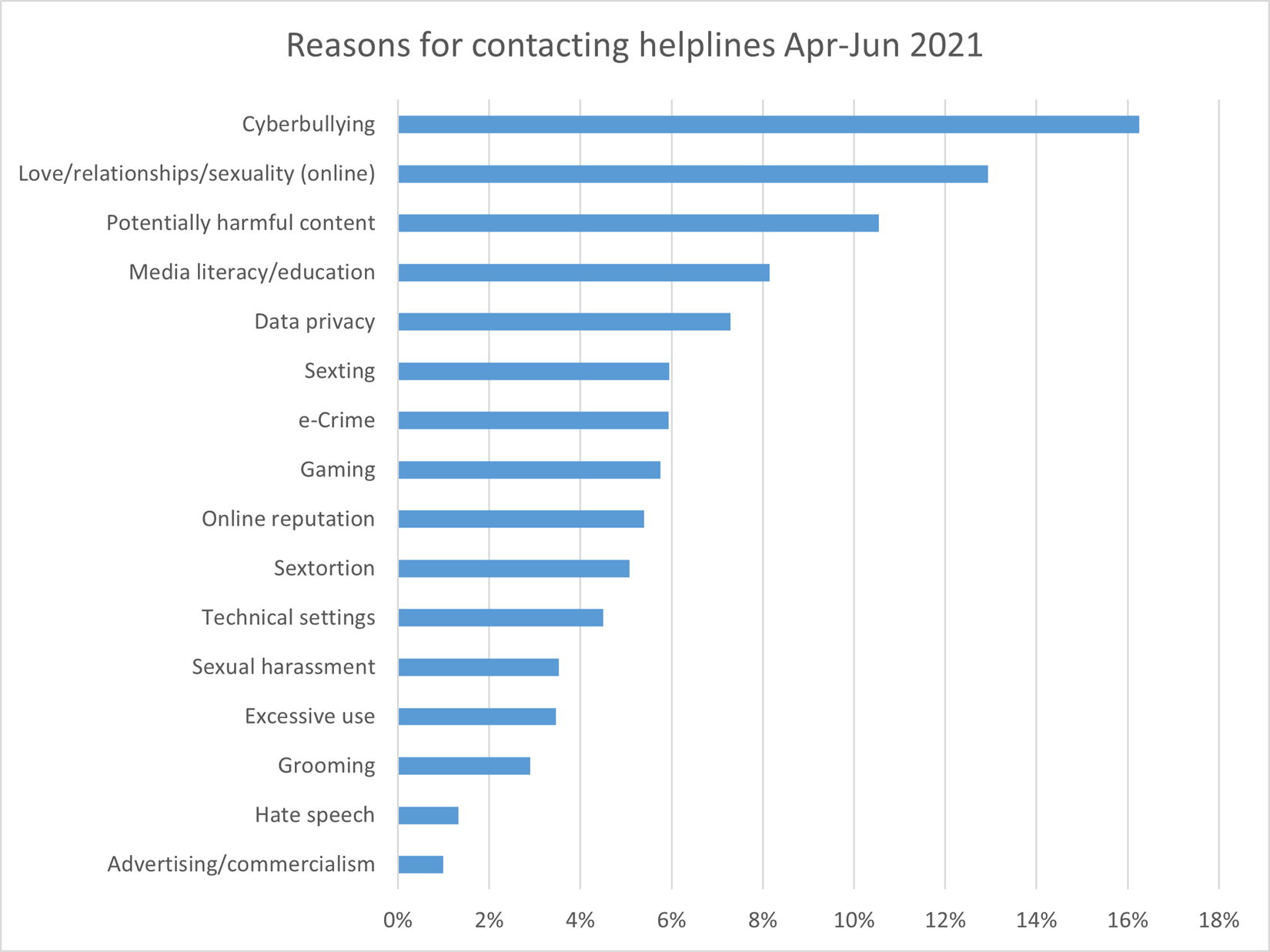The Insafe network of helplines collects data about the types of calls received and this is analysed every three months to look at trends, and new and emerging issues. The most recent helpline data covers the period from April to June 2021 and, unusually, saw a reduction in the number of calls when compared to the previous reporting period. During Q1 there were over 17,000 contacts made to helplines but only 15,733 during Q2. However, this is due in part to changes in the way that some helplines are collecting and reporting data.

Who is contacting helplines?
Despite the lower number of contacts, data collected over time shows an upward trend in contacts since the start of 2019. As always, the main user group are teens (aged 12 to 18) who account for 58 per cent of all those who contact helplines. Not surprisingly, there are variations across the different helplines with over 95 per cent of contacts in Norway coming from teens, compared to only seven per cent in Greece. The percentage of parents contacting helplines has been increasing over the last three reporting periods whereas the percentage of teachers has been decreasing. There has also been a decrease in the percentage of social workers contacting helplines. Some helplines have commented that teachers, in particular, have had excessive workloads during the past year, being preoccupied with moving lessons and learning online, then reopening schools, while also dealing with the impact of COVID-19 on an ongoing basis.
How are users contacting helplines?
Around 60 per cent of all contacts to helplines are made by phone. This had declined during COVID lockdowns but has now risen to pre-pandemic levels. Some helplines have organised specific media campaigns aimed at promoting a new helpline number which will have had some impact on these figures. Helplines are increasingly turning to different ways for users to make contact and trying, where possible, to make use of apps and platforms that are particularly popular with children and young people. For example, the Spanish helpline has offered the possibility of contacting them using WhatsApp or Telegram. Chat as a method of contact now accounts for a quarter of all cases.
What issues are being addressed?
Helplines record contacts against 16 different categories and, as usual, the main reason for contacting a helpline is cyberbullying with over 16 per cent of contacts relating to this. It was noted that there has been a reduction of two percentage points in calls related to excessive use. Some helplines have suggested that this is as a result of the pandemic for two reasons. Firstly, parents and carers have accepted that their children are going to spend more time online, particularly during lockdowns. Secondly, this reporting period saw schools reopening in many countries and this will have led to re-balancing of time spent on and offline. 13 per cent of contacts were related to love, relationships and sexuality online. Apart from cyberbullying, this category is the most common reason to get in touch with a helpline and highlights the pressures that children and young people feel as they try to navigate relationships in a world that is increasingly online. This quarter shows the highest percentage of calls relating to this area.

Figure 1: Reasons for contacting helplines April – June 2021 (© Better Internet for Kids)
| Reasons for contacting Insafe helplines | Percentage of contacts |
|---|---|
| Advertising/commercialism | 0.99 per cent |
| Hate speech | 1.32 per cent |
| Grooming | 2.90 per cent |
| Excessive use | 3.47 per cent |
| Sexual harassment | 3.53 per cent |
| Technical settings | 4.51 per cent |
| Sextortion | 5.07 per cent |
| Online reputation | 5.40 per cent |
| Gaming | 5.75 per cent |
| e-Crime | 5.94 per cent |
| Sexting | 5.95 per cent |
| Data privacy | 7.30 per cent |
| Media literacy/education | 8.15 per cent |
| Potentially harmful content | 10.54 per cent |
| Love/relationships/sexuality (online) | 12.93 per cent |
| Cyberbullying | 16.25 per cent |
The Insafe network of helplines collects data about the types of calls received and this is analysed every three months to look at trends, and new and emerging issues. The most recent helpline data covers the period from April to June 2021 and, unusually, saw a reduction in the number of calls when compared to the previous reporting period. During Q1 there were over 17,000 contacts made to helplines but only 15,733 during Q2. However, this is due in part to changes in the way that some helplines are collecting and reporting data.

Who is contacting helplines?
Despite the lower number of contacts, data collected over time shows an upward trend in contacts since the start of 2019. As always, the main user group are teens (aged 12 to 18) who account for 58 per cent of all those who contact helplines. Not surprisingly, there are variations across the different helplines with over 95 per cent of contacts in Norway coming from teens, compared to only seven per cent in Greece. The percentage of parents contacting helplines has been increasing over the last three reporting periods whereas the percentage of teachers has been decreasing. There has also been a decrease in the percentage of social workers contacting helplines. Some helplines have commented that teachers, in particular, have had excessive workloads during the past year, being preoccupied with moving lessons and learning online, then reopening schools, while also dealing with the impact of COVID-19 on an ongoing basis.
How are users contacting helplines?
Around 60 per cent of all contacts to helplines are made by phone. This had declined during COVID lockdowns but has now risen to pre-pandemic levels. Some helplines have organised specific media campaigns aimed at promoting a new helpline number which will have had some impact on these figures. Helplines are increasingly turning to different ways for users to make contact and trying, where possible, to make use of apps and platforms that are particularly popular with children and young people. For example, the Spanish helpline has offered the possibility of contacting them using WhatsApp or Telegram. Chat as a method of contact now accounts for a quarter of all cases.
What issues are being addressed?
Helplines record contacts against 16 different categories and, as usual, the main reason for contacting a helpline is cyberbullying with over 16 per cent of contacts relating to this. It was noted that there has been a reduction of two percentage points in calls related to excessive use. Some helplines have suggested that this is as a result of the pandemic for two reasons. Firstly, parents and carers have accepted that their children are going to spend more time online, particularly during lockdowns. Secondly, this reporting period saw schools reopening in many countries and this will have led to re-balancing of time spent on and offline. 13 per cent of contacts were related to love, relationships and sexuality online. Apart from cyberbullying, this category is the most common reason to get in touch with a helpline and highlights the pressures that children and young people feel as they try to navigate relationships in a world that is increasingly online. This quarter shows the highest percentage of calls relating to this area.

Figure 1: Reasons for contacting helplines April – June 2021 (© Better Internet for Kids)
| Reasons for contacting Insafe helplines | Percentage of contacts |
|---|---|
| Advertising/commercialism | 0.99 per cent |
| Hate speech | 1.32 per cent |
| Grooming | 2.90 per cent |
| Excessive use | 3.47 per cent |
| Sexual harassment | 3.53 per cent |
| Technical settings | 4.51 per cent |
| Sextortion | 5.07 per cent |
| Online reputation | 5.40 per cent |
| Gaming | 5.75 per cent |
| e-Crime | 5.94 per cent |
| Sexting | 5.95 per cent |
| Data privacy | 7.30 per cent |
| Media literacy/education | 8.15 per cent |
| Potentially harmful content | 10.54 per cent |
| Love/relationships/sexuality (online) | 12.93 per cent |
| Cyberbullying | 16.25 per cent |
- risks online online safety helpline
Related content
- < Previous article
- Next article >











